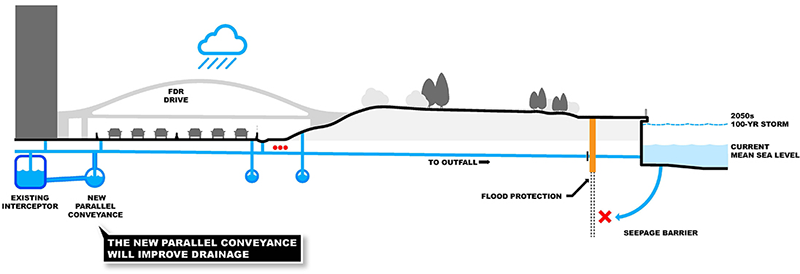
 East Side Coastal Resiliency311
East Side Coastal Resiliency311 Search all NYC.gov websites
Search all NYC.gov websites
Project Elements
Resiliency and Flood Protection
Due to climate change, sea levels are rising and coastal storms are becoming more frequent and severe. The East Side Coastal Resiliency project will address these threats by reducing flood risk to property, landscapes, businesses, and critical infrastructure while also improving waterfront open spaces and access. An integrated flood protection system is being constructed across a 2.4-mile span, which includes waterfront open spaces, sections of the FDR Drive, urban streets, residences, businesses, schools and other vital infrastructure, including a pump station and electrical substation.
ESCR's various elements, which include a combination of raised parkland, floodwalls, floodgates and infrastructure improvements, will be integrated into the urban design fabric and will enhance access to the waterfront while providing long-term flood protection.
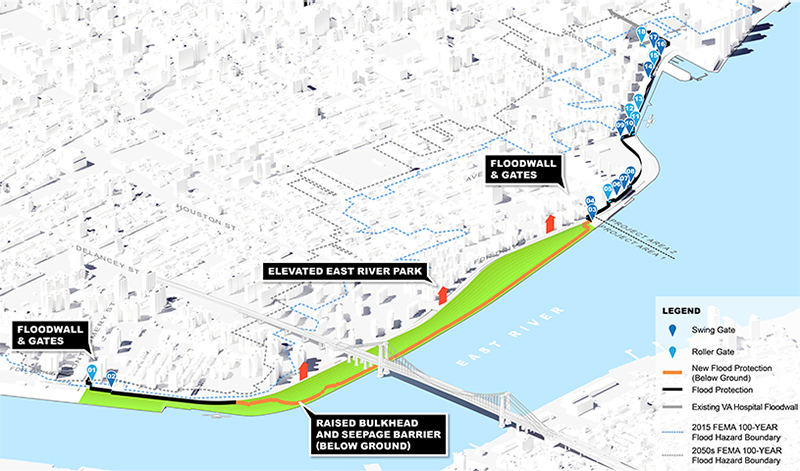
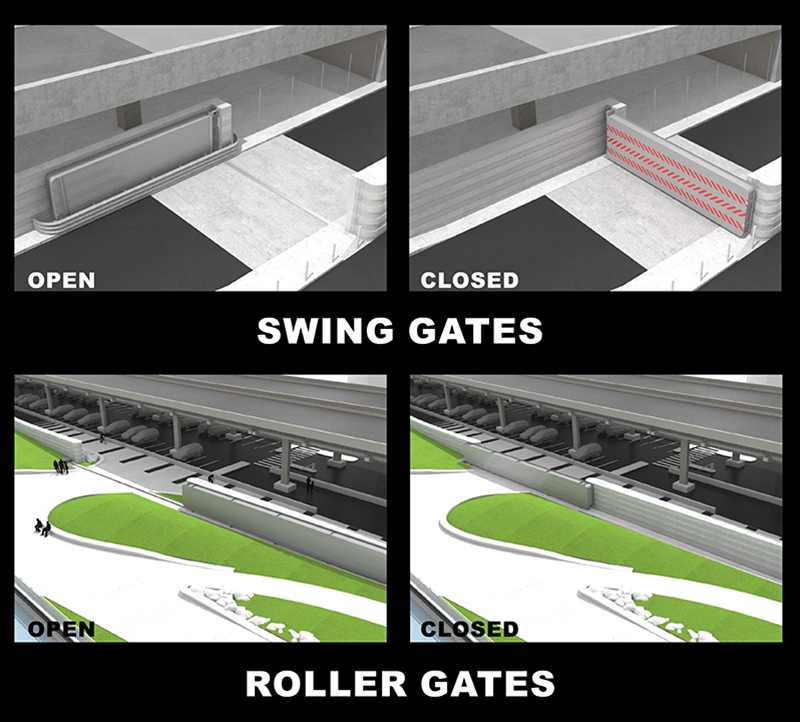
Click a topic, or press the enter key on a topic, to reveal its answer.
Design Height
The ESCR project is deeply rooted in science and sound engineering and is designed to protect generations of New Yorkers. The project is grounded in future climate change projections produced by the New York City Panel on Climate Change (NPCC), an independent body composed of some of the world's most highly credentialed climate scientists. ESCR is designed to a highly protective standard, using the extreme, low probability sea level rise projections for the 2050s. This standard is equivalent to the projections considered likely by climate scientists for 2100. The project was engineered with a useful life of 100 years. Throughout the project, the height of the flood protection will range from 8-9 feet above existing grade.
Climate change is a dynamic threat and the severity of its impacts will depend on how quickly we reduce carbon emissions worldwide. For this reason, ESCR utilizes an adaptive design that can accommodate the addition of two more feet of elevation should sea levels in the coming decades rise significantly faster than present day projections anticipate.


Floodwalls
Several floodwalls are integrated into the project's landscape to provide flood protection throughout the project area. At the far southern end of the project, the floodwall will run along the FDR Drive from Montgomery Street to the southern end of the existing amphitheater, where it's alignment will turn eastward toward the water.
Additionally, East River Park will be raised to provide flood protection for both the park itself and the residential communities behind it. The elevated East River Park will prevent storm surge from overtopping the bulkhead at the water's edge. From that point, the landscape of the park will slope gradually downward to meet the existing grade at FDR Drive, resulting in an inviting view from the west and lining the FDR drive with greenery.
A floodwall will connect to the north face of the Con Edison Generating Station building at 15th Street and continue north between the edge of Con Edison's parking lot and the FDR Drive to Murphy Brothers Playground. The above-ground floodwall at Murphy Brothers Playground will be aligned with the east side of the park, protecting the facilities from sea level rise and storm surge. A combination of floodwalls and floodgates will cross the FDR Drive ramps to the western edge of Stuyvesant Cove Park where they will be integrated with the park's waterfront edge. From Stuyvesant Cove Park, the floodwall continues over to the Asser Levy Pool area, utilizing roller and swing gates to cross roadways. At the northern end of the project area, the reconstructed Asser Levy Playground will include landscape integration with an above-ground floodwall that will tie-in with an existing VA Hospital floodwall on the north side of the hospital's property at East 24th Street.
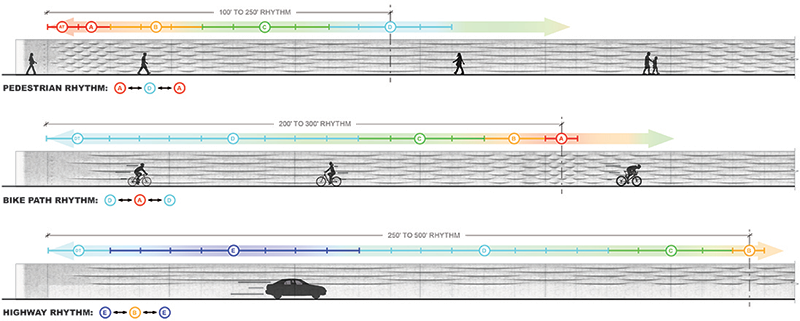
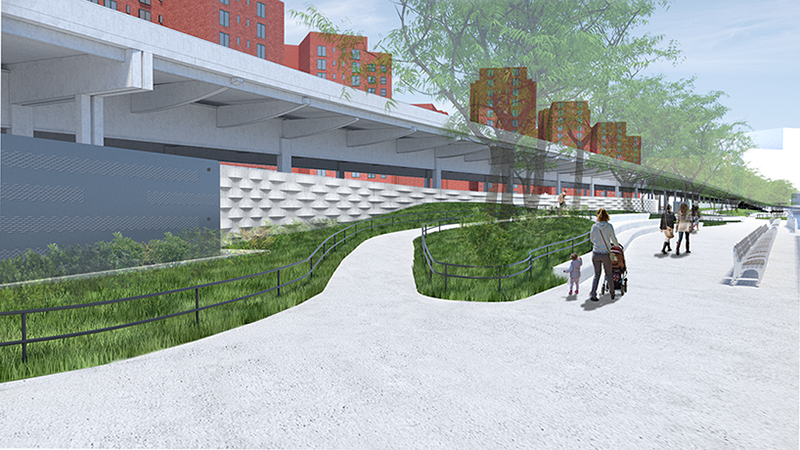
Floodgates
The ESCR project utilizes floodgates to ensure continued connections between the neighborhood and the waterfront. These floodgates will remain open in "blue sky" conditions and will only be closed in the event of a coastal storm. Eighteen flood gates, including both roller gates and swing gates, are utilized throughout the project site. The design of these structures matches the floodwall design.
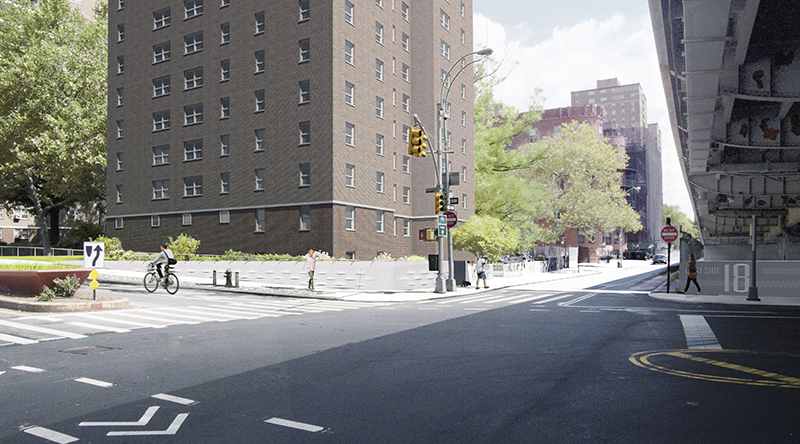
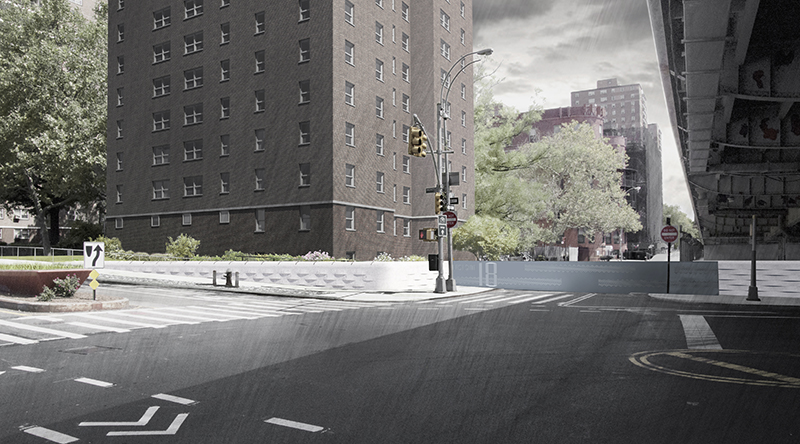
Combined Sewer System
The ESCR project will include numerous modifications and additions to the existing combined sewer system. New sewer lines will be constructed to reduce inland flooding caused by rainfall. These new lines will increase capacity within the system and convey excess water flow to the Manhattan Pump Station during storms. The new parallel conveyance system ensures that wastewater is transported to the treatment plant for processing.
Additionally, two underground interceptor gates will be installed on the branch interceptor at the northern and southern ends of the project. These gates will block sewer system flows from adjacent areas. New aboveground structures housing critical equipment will also be constructed at both of these locations.
